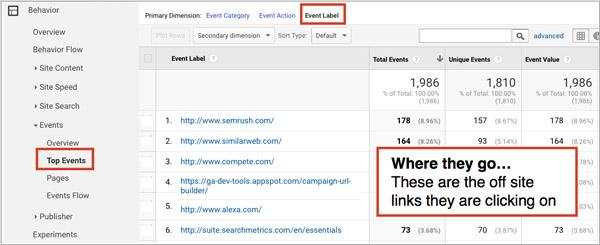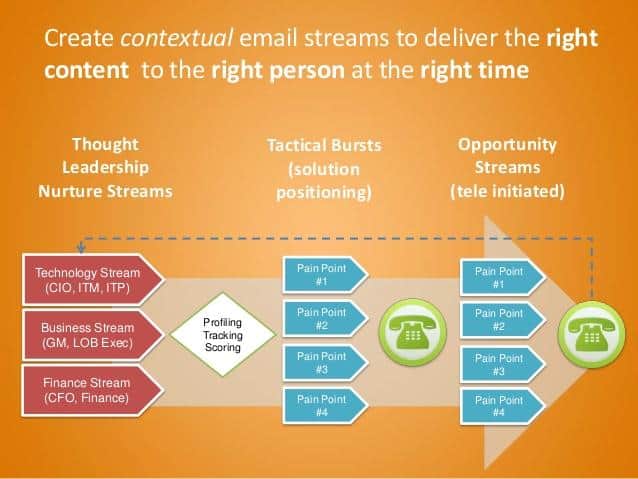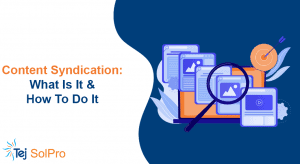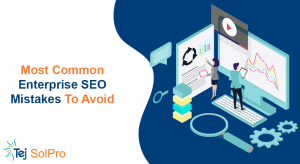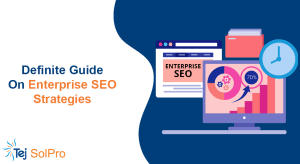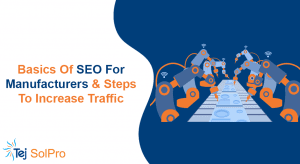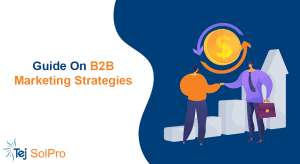SaaS provider Marketo defines Account Based Marketing as “an alternative B2B strategy that concentrates sales and marketing resources on a clearly defined set of target accounts within a market and employs personalized campaigns designed to resonate with each account.”
The typical Account Based Marketing program follows these 5 essential steps:
- Identify and flesh out your high-value accounts.
- Develop personalized content for each persona in the account.
- Reach out to your target account via optimal channels.
- Nurture target accounts.
- Convert, measure and learn.
Account Based Marketing or ABM for short, is what inbound marketing was to digital marketers 5 years ago. Where inbound marketing tries to attract as many leads as possible and then converts those leads into customers, ABM takes the reverse approach. Account Based Marketing focuses on a handful of key accounts and puts the full force of the marketing stack behind converting those.
So if ABM takes a diametrically opposite approach to lead generation and conversions compared to inbound marketing, does that mean the foundation of inbound marketing – SEO – is irrelevant to ABM?
Not quite.
Any SEO practitioner will see the similarities between the ABM process discussed above and a diligent SEO and content marketing strategy. Let’s take a deeper dive to discover the different ways SEO can add wings to your ABM program at every step.
Contents
Identify and Flesh Out Your High-Value Accounts
Laser focus on a handful of accounts is the guiding philosophy of Account-Based Marketing. Dig into your list of target clients and pick out the most lucrative accounts using criteria that best suit your business. Some vetting criteria to use include:
- Account’s revenue potential
- Market potential
- Competitive position
- Your relationship with the account (chances of conversion)
Once you’ve filtered your “wish list” down to a practical, short and targeted list of accounts, it’s time to truly “discover” the account inside out.
Starting with the key influencers and decision makers at the target company, create a map of all the different contacts you need to target at the company. An enterprise purchase is influenced by close to 17 people on average according to the ABM Outlook Survey 2018. Your number might be smaller or bigger depending on the scale of the target account.
Your next job is to find out as much as you can about each of the contacts at your target company and build detailed personas for them. Job title, role, current products used (in your niche), stage of the buying funnel, and favorite media platforms and channels are some of the typical things you’ll unearth for each contact to build their persona.
How SEO helps
As you draw a clear picture of each contact, from influencer to decision maker, you’ll realize that each individual has distinctly different concerns. This difference in priorities means that what matters to each one is different. Therefore, the topics (read, keywords) that resonate most with each contact are unique. Develop a list of terms and phrases that would suit each persona in the account. This study of intent that goes hand in hand with your account research will form the foundation of your ABM program.
Develop Personalized Content for Each Persona
You don’t need me to tell you that personalized content converts better than generic content. This is even more applicable in B2B contexts where purchase decisions are long drawn, high stakes, expensive processes where each stakeholder needs as much relevant information as possible.
A recent study found that stakeholders who found content from potential vendors to be personalized to their concerns were 40% more likely to buy than those who were served generic content.
Any ABM program that’s serious about conversions needs to dedicate the time and resources to develop content that is directly engaging for each of the key contacts in their account.
How SEO helps
SEO is the guiding force behind a big percentage of personalized content out there on the internet. Once you know what keywords to target to which persona, the question of personalization becomes straightforward. From developing unique content just for a single persona to customizing content using the relevant keywords on landing pages, to creating marketing copy for different personas using keywords that resonate with them, the various ways you can personalize content are endless.
Set up user tracking in your Google Analytics account and you can drill down to the actual keywords that your target contacts searched for on your site. You can then use these specific keywords for creating content that takes personalization to a 1:1 level. Alternately, linking your Google Analytics account to your CRM platform like Salesforce gives you detailed activity tracking for each contact. Pages visited, time spent per page, keywords searched and more are all at your fingertips.
A strong SEO backing to your ABM program offers answers to specific queries (keywords!) that the different stakeholders at your target account have in mind.
Reach Out to Your Target Account via Optimal Channels
Creating personalized content is not enough. Your custom content has to reach your contacts through the channels that they prefer. Consider the process of targeting each contact within an account exactly the way you’d consider building a regular marketing campaign targeted at thousands of users.
You do your background research, understand the media and channel preferences of your audience and then publish your content on those platforms to ensure maximum visibility.
Quick tip: Search is the #1 channel for researching new product purchases for B2B users. 90% of B2B users rely on online searches to find more information about product details features, comparisons and more.
How SEO helps
By optimizing your site for the specific keywords that matter to your contacts, you’re maximizing the chances of your content ranking high on online searches. With the vast majority of users heading to search engines to research about their B2B purchases, SEO offers the perfect path to getting in front of your target user.
SEO is not just about keywords. It’s also about URLs – backlinks as well as outbound links. With Google Tag Manager, you can set up events where you can clearly see which site your users go to from your own site.
Once you know where your users head to from your site, you’ll have a clearer idea of where to advertise and how to communicate to your target contacts.
Nurture Target Accounts
ABM recommends creating dedicated nurture streams with personalized content for each of the contacts in your target accounts. Use your custom content to move your stakeholders from one part of the sales funnel to the next.
It’s important to use the right type of content at the right time – blog posts and articles are great when the user is at the top of the funnel. But you require more in-depth content to nudge your user along the conversion funnel, including research or surveys supporting your point of view and case studies of actual clients that have tasted success with your methods.
How SEO helps
SEO helps create this custom content for each stage of the sales funnel. With this, it not only helps improve the chances of conversion for new contacts, it also helps nurture relationships with existing contacts. You can extract more value from existing accounts with the right types of messaging. This could be in the form of repeat purchases or even upselling and cross-selling items related to the customer’s last purchase.
Convert, Measure and Learn
This is the final step in the ABM process. Hopefully, all that personalized treatment paid off and your stakeholders sign off on buying your product/service. Once the dust settles, you have the time and luxury to look back and understand what went well and what could have been handled better with each converted account. For that matter, accounts that do not convert teach you even more and help make your future campaigns more targeted and precise. Key metrics to track include
- Coverage of all stakeholders involved in the buying decision
- The engagement rate of contacts (stakeholders) at each stage of the sales cycle
- Calls and meetings resulting from ABM
- Number of prospects in the pipeline
- Time taken to convert
How SEO helps
Since SEO helps content marketing achieve similar goals as the ones listed above, it offers a handy benchmark to compare your ABM performance against traditional content marketing results. With ABM considered as a turbo-charged approach to B2B marketing, the expectation is to see better results through this method as compared to inbound and content marketing.
Old Wine, New Bottle
Not everything gets left behind as you move ahead from one process to a better one. As we saw in the previous sections, there’s great value in the old faithful. All it takes is some creativity in blending the old with the new to offer results that are not just better, but also quicker to fruition.
Do you use account-based management at your agency? What successes have you tasted? What obstacles are you facing in conversion? How do your results compare to inbound marketing or push marketing? Please let me know in the comments!


